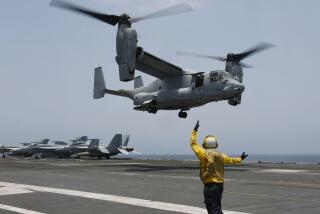Osprey Needs Too Much TLC, Marines Found
- Share via
WASHINGTON — A Marine investigation into the fatal crash of an Osprey aircraft in April warned of the high maintenance needs of the plane’s hydraulic system, which was identified as the likely cause of a subsequent Osprey crash in December, according to a report from the General Accounting Office.
Previously undisclosed parts of the accident report said that the need for intensive maintenance of the hydraulic system is cause for concern, according to the GAO. The Marine accident investigation, known as a Judge Advocate General Manual, also said that the Osprey was “unforgiving” to pilots, the GAO said.
The Osprey is an innovative aircraft with rotors that can tilt from horizontal to vertical position, enabling the craft to take off like a helicopter but fly at the higher speed of an airplane. The hybrid plane has been championed by the Marines as the best replacement for their aging helicopter fleet.
23 Marines Died in 2 Accidents
But the program has recently drawn criticism because of the two accidents last year, which together killed 23 Marines. Compounding the controversy, the Pentagon disclosed earlier this month that one or more Marines allegedly falsified maintenance data to make the plane look good.
The Marine accident report, released in July, found that the Osprey crashed in April because of pilot error. The pilots had allowed the Osprey to go into a rapid descent that, given the aircraft’s slow forward speed, caused the Osprey to lose lift and spin out of control.
The 6,000-page accident report said that this problem was “not the result of any design, material or maintenance factor specific to tilt rotors.” Yet the report noted that “many maintenance hours have been spent maintaining and servicing the various aircraft hydraulic systems.”
The Osprey’s complex hydraulic system has attracted criticism from other quarters.
The Pentagon’s top weapons testing official, in a report last fall, said that the Osprey is not “operationally suitable” for its assigned mission because of the difficulty of maintaining its complex machinery, including the hydraulic system.
Though the Osprey was intended to be simpler and easier to maintain than the helicopters it is to replace, it has yet to lived up to that goal, said Philip E. Coyle, who recently stepped down as head of the testing office.
The Osprey’s hydraulics system is an advanced technology that is designed to operate at 5,000 pounds per square inch, more than twice the pressure used in many other military aircraft.
The Marine investigators’ comments were reported in a GAO analysis that was prepared for a blue-ribbon panel that is now reviewing the Osprey program.
Time magazine and Defense Week, an industry publication, first reported the GAO findings.
The Marines released a 100-page summary version of the accident report in July. But large parts of the report were omitted, including comments on the high maintenance needs of the hydraulic system.
Lt. David Nevers, a Marine spokesman, said that sections which are “opinion or recommendations” are routinely deleted from such accident reports. That is done to encourage investigating officers to offer their candid appraisals without worry that their views will be subject to public scrutiny, he said.
Marine officials insist that the Osprey is reliable and easy to fly. They say it has been repeatedly tested.
Marine Commandant Still Confident, He Says
In an interview last week, Marine Commandant James L. Jones said the questions asked about the Osprey are “legitimate.” But, he said, Marine fliers strongly support the Osprey program and noted that he is personally confident the aircraft will prove its worth.
“No one has come to me and said this technology is too hard, this technology is too risky, this technology breaks too easily,” he said.
Jones said he was unaware that the Arizona accident investigators had voiced concern about the Osprey’s hydraulic system.
Senior Bush administration officials, who must decide whether to begin full-scale production of the aircraft, say that they, too, view the questions as grave.
Vice President Dick Cheney said Sunday that, “given the track record and the loss of life so far, it would appear to me that there are very serious questions that can and should be--and I hope they will be--raised about the Osprey.”
Cheney noted on ABC’s “This Week” that a decade ago, as Defense secretary, “I tried to kill the Osprey on about three occasions” because of its price.
More to Read
Sign up for Essential California
The most important California stories and recommendations in your inbox every morning.
You may occasionally receive promotional content from the Los Angeles Times.














